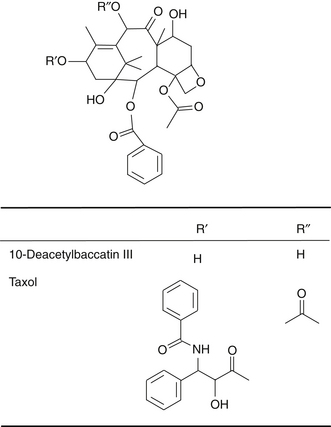Chapter 128 Taxus brevifolia (Pacific Yew)
Taxus brevifolia (family: Taxaceae)
 General Description
General Description
Paclitaxel (Taxol) and complex diterpenoid taxanes are compounds found in Taxus brevifolia. Docetaxel (Taxotere) is a semisynthetic agent similar in action to paclitaxel derived from 10-deacetyl baccatin III, a taxane isolated from the needles of Taxus baccata, the English yew. Prior to their formal drug development, these compounds were cited as among the most promising plant compounds tested for anticancer properties in 1990.1 The Pacific yew was first collected in 1962 by a U.S. Department of Agriculture team in Washington State as part of the large natural products screening program of the U.S. National Cancer Institute. Confirmed activity by a bark extract against the KB cell line in tissue culture was reported in 1964. Isolation studies began in 1965, and by 1971, Wall et al2 at the Research Triangle Institute (Durham, N.C.) had identified paclitaxel as the active constituent.2 Paclitaxel became big news in 1989, when investigators at the Johns Hopkins Oncology Center in Baltimore reported a 30% response rate in cases of refractory ovarian cancer, a remarkable rate for this type of cancer.3 The development of docetaxel began in 1981 in France. Taxanes used in conjunction with chemotherapy and irradiation have demonstrated improved results as compared with either of these therapies alone as well as better tolerance of these therapies.3a
 Chemical Composition
Chemical Composition
The Pacific yew is poisonous because it contains at least 11 alkaloids, known collectively as taxines. The structure of only two of the alkaloid constituents is known: taxine A, which accounts for 30%, and taxine B, which accounts for 2%. Paclitaxel (Figure 128-1) is a pseudoalkaloid but not a constituent of taxine because its nitrogen is acylated with benzoic acid and has no basic principle. The concentration of paclitaxel in yew bark is low, only 0.01%.
 History and Folk Use
History and Folk Use
Historically, the yew has been highly valued for its dense, resilient, decay-resistant, tight-grained wood and its medicinal properties. The Greeks named the yew toxus in reference to its use for making a strong bow (toxon), and its poisonous nature (toxikon).2 It was used as an animal and fish poison by primitive cultures as well as for murder and suicide. In the first century AD, Claudius suggested its use as an antidote for viper bites. Europeans used it as an abortifacient as well as to treat heart ailments and hydrophobia.2 Native Americans used the yew for many ailments, as follows:
Women ate yew berries to prevent conception. Youths rubbed smooth sticks of yew on their developing bodies to gain its strength. Both the bark and the leaves have been brewed for tea, and powders have been made from the bark alone. The fleshy red aril (berry) that surrounds the seed is not poisonous, although the seed itself is.4
There is a lot of folklore about the yew’s supernatural powers. Because it is a slow-growing, long-lived tree, it was associated with immortality and used in spells to raise the dead.5 Because it was regarded as among the most potent of trees for protection against evil, it was considered unlucky to cut down or damage a yew tree. Many were planted in churchyards/graveyards and alongside homes for protection. Specimens survive today in spite of main trunks being hollowed out from decay following hundreds of years of existence.
 Pharmacology
Pharmacology
Paclitaxel’s anticancer action is unique in that it inhibits cell division by promoting the formation of microtubules, the rodlike structures that function as a cell skeleton, making cells more stable and resistant to depolymerization. In contrast, other anticancer phytoagents (e.g., colchicine and vinca alkaloids) induce the polymerization of microtubules. In addition, under the influence of paclitaxel, the microtubules polymerize independently of the microtubule-organizing center, which is in a perinuclear area, and instead localize predominantly in the cell’s periphery.6 This interferes with the mitotic spindle and selectively blocks cells in the G2 and M phases of the cell cycle, the most radiosensitive phases. Additionally, paclitaxel induces the formation of abnormal spindle asters that do not require centrioles for enucleation and are reversible after treatment.7–10 Furthermore, in vivo, paclitaxel has demonstrated an ability to activate the local release of an apoptosis-inducing cytokine.11 Studies on cancer cell lines induced with gml, a novel gene, have demonstrated a marked increase in sensitivity to paclitaxel via apoptosis. An assay for gml expression could serve as a clinically useful predictor of chemotherapeutic sensitivity.12



